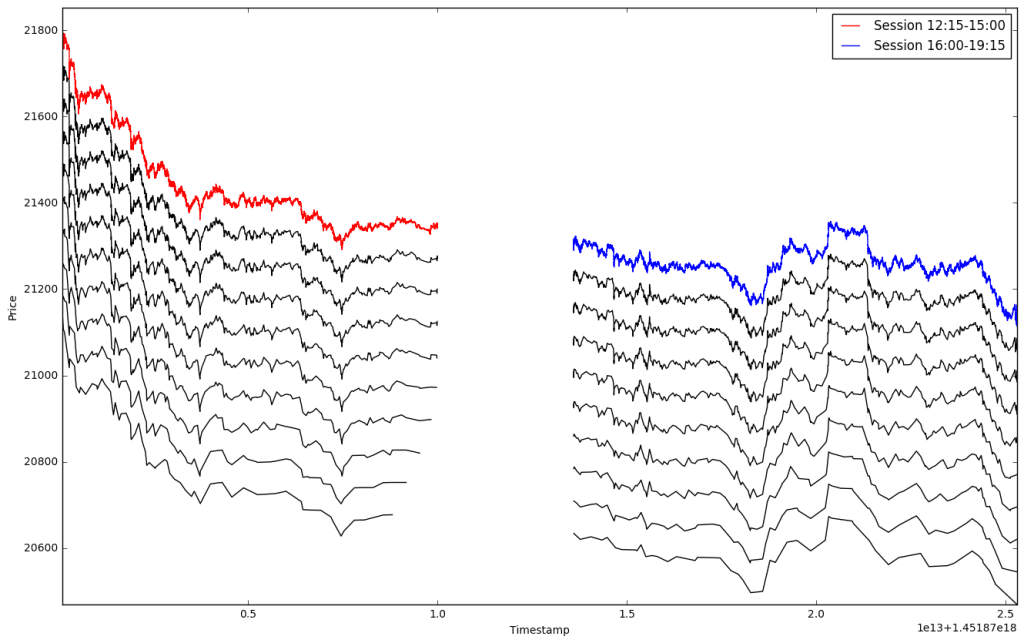A determination of peaks and troughs for any financial time-series seems to be always in high demand, especially in algorithmic trading. A number of numerical methods can be found in the literature. The main problem exists when a smart differentiation between a local trend and “global” sentiment needs to be translated into computer language. In this short post, we fully refer to the publication of Yin, Si, & Gong (2011) on Financial Time-Series Segmentation using Turning Points wherein the authors proposed an appealing way to simplify the “noisy” character of the financial (high-frequency) time-series.
Since this publication presents an easy-to-digest historical introduction to the problem with a novel pseudo-code addressing solution, let me skip this part here and refer you to the paper itself (download .pdf here).
We develop Python implementation of the pseudo-code as follows. We start with some dataset. Let us use the 4-level order-book record of Hang Seng Index as traded over Jan 4, 2016 (download 20160104_orderbook.csv.zip; 8MB). The data cover both morning and afternoon trading sessions:
import pandas as pd
import numpy as np
import matplotlib.pyplot as plt
# Reading Orderbook
data = pd.read_csv('20160104_orderbook.csv')
data['MidPrice0'] = (data.AskPrice0 + data.BidPrice0)/2. # mid-price
# Split Data according to Sessions
delta = np.diff(data.Timestamp)
# find a good separation index
k = np.where(delta > np.max(delta)/2)[0][0] + 1
data1 = data[0:k].copy() # Session 12:15-15:00
data2 = data[k+1:].copy() # Session 16:00-19:15
data2.index = range(len(data2))
plt.figure(figsize=(10,5))
plt.plot(data1.Timestamp, data1.MidPrice0, 'r', label="Session 12:15-15:00")
plt.plot(data2.Timestamp, data2.MidPrice0, 'b', label="Session 16:00-19:15")
plt.legend(loc='best')
plt.axis('tight')
Turning Points pseudo-algorithm of Yin, Si, & Gong (2011) can be organised using simple Python functions in a straightforward way, namely:
def first_tps(p):
tp = []
for i in range(1, len(p)-1):
if((p[i] < p[i+1]) and (p[i] < p[i-1])) or ((p[i] > p[i+1]) \
and (p[i] > p[i-1])):
tp.append(i)
return tp
def contains_point_in_uptrend(i, p):
if(p[i] < p[i+1]) and (p[i] < p[i+2]) and (p[i+1] < p[i+3]) and \
(p[i+2] < p[i+3]) and \
(abs(p[i+1] - p[i+2]) < abs(p[i] - p[i+2]) + abs(p[i+1] - p[i+3])):
return True
else:
return False
def contains_point_in_downtrend(i, p):
if(p[i] > p[i+1]) and (p[i] > p[i+2]) and (p[i+1] > p[i+3]) and \
(p[i+2] > p[i+3]) and \
(abs(p[i+2] - p[i+1]) < abs(p[i] - p[i+2]) + abs(p[i+1] - p[i+3])):
return True
else:
return False
def points_in_the_same_trend(i, p, thr):
if(abs(p[i]/p[i+2]-1) < thr) and (abs(p[i+1]/p[i+3]-1) < thr):
return True
else:
return False
def turning_points(idx, p, thr):
i = 0
tp = []
while(i < len(idx)-3):
if contains_point_in_downtrend(idx[i], p) or \
contains_point_in_uptrend(idx[i], p) \
or points_in_the_same_trend(idx[i], p, thr):
tp.extend([idx[i], idx[i+3]])
i += 3
else:
tp.append(idx[i])
i += 1
return tp
The algorithms allows us to specify a number $k$ (or a range) of sub-levels for time-series segmentation. The “deeper” we go the more distinctive peaks and throughs remain. Have a look:
thr = 0.05
sep = 75 # separation for plotting
P1 = data1.MidPrice0.values
P2 = data2.MidPrice0.values
tp1 = first_tps(P1)
tp2 = first_tps(P2)
plt.figure(figsize=(16,10))
plt.plot(data1.Timestamp, data1.MidPrice0, 'r', label="Session 12:15-15:00")
plt.plot(data2.Timestamp, data2.MidPrice0, 'b', label="Session 16:00-19:15")
plt.legend(loc='best')
for k in range(1, 10): # k over a given range of sub-levels
tp1 = turning_points(tp1, P1, thr)
tp2 = turning_points(tp2, P2, thr)
plt.plot(data1.Timestamp[tp1], data1.MidPrice0[tp1]-sep*k, 'k')
plt.plot(data2.Timestamp[tp2], data2.MidPrice0[tp2]-sep*k, 'k')
plt.axis('tight')
plt.ylabel('Price')
plt.xlabel('Timestamp')
It is highly tempting to use the code as a supportive indicator for confirmation of new trends in the time-series (single) or build concurrently running decomposition (segmentation; at the same sub-level) for two or more parallel time-series (e.g. of the FX pairs). Enjoy!


3 comments
Hi Pawel,
Nice idea and good post.
Q: While fully understanding the concept, what’s the difference between this approach and applying a zig-zag indicator with various thresholds?
The *last leg is always the problem, while trends look great *in retrospect.
Best,
Dan Valcu, CFTe
I have a similar question about this indicator. I think its great for ex post regime segmentation but how can you use it ex-ante. I am not sure how it can be applied to forward looking forecasts, as opposed to backwards looking filtration? Seems like TA posing as quantitative finance.
True. I would recommend to use it as a tool to build a statistical estimator of a directional change of trading direction. One can check on longer (lower granularity) time-scales what is the characteristic of the underlying high-frequency time-series. Next, collect all information from those segments in order to estimate the most current period to go up or down, i.e. only being supported by a great number of similar cases from such a backtest. Is it worth doing it… Your call :-)